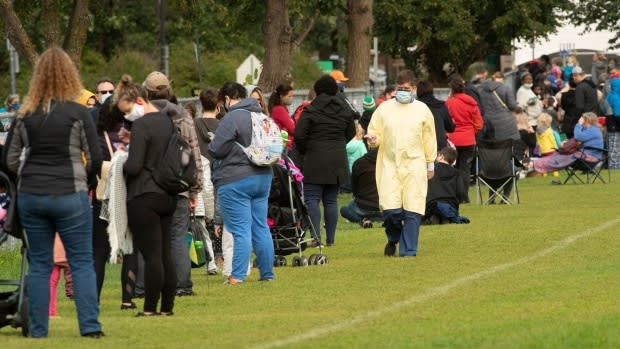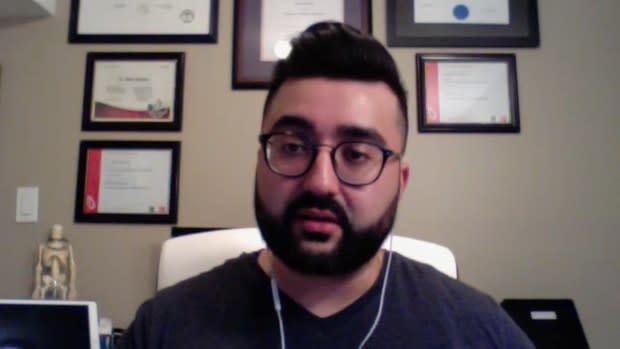Ontario waited weeks to trigger restrictions while COVID-19 spread. Did changes come too late?

For months, Ryan Imgrund has meticulously tracked the ebbs and flows of coronavirus transmission in Ontario.
New weekly COVID-19 cases per capita. Infections tied to community transmission. The shifts in impacted regions and age groups.
After the Civic Holiday weekend in early August, one rising metric stood out to the biostatistician: The virus's Rt value — the number of cases linked to every primary infection — went above 1.0 after a summer lull.
It signalled a shift to exponential growth, where every one person carrying the virus could infect 1.1 more, and so on.
"That's when my alarm bells started going off," said Imgrund, who works at Southlake Regional Health Centre in Newmarket, Ont..
As the weeks passed and summer turned to fall, those alarms rang louder and louder. Clinicians, epidemiologists and hospital leaders all started sharing other concerning metrics — including rising demand for testing, spikes in hospital admissions, long-term care outbreaks — and pushed Ontario to take action.

But it wasn't until Friday that provincial health officials announced a sweeping rollback to earlier restrictions for the hot zones of Toronto, Peel Region and Ottawa, including the closing of restaurants, gyms, movie theatres, casinos and other indoor gathering spots.
A bid to curb runaway case growth before yet another holiday weekend, the move came the same day Ontario reported a new record high of more than 900 COVID-19 cases.
So why now?
Why not take action on Thursday, when critical-care physicians flagged a one-day spike in ICU admissions not seen since early June?
Why not a week ago, when Toronto's medical officer of health called for indoor dining and fitness centre closures to stop "exponential growth" in infections?
Why not in early October, after the province's own modelling data projected 1,000 new cases each day?
Why not sometime in September, when cases and hospitalizations were rising while new infections shifted from mostly younger adults to more older, vulnerable Ontarians?
Why not back in August, when the reproductive number Imgrund kept tracking hit the tipping point for case growth — an early signal of trouble to come?
"A couple weeks ago, we didn't see these numbers," Premier Doug Ford told reporters on Friday, referring to this week's record-breaking case growth, which spiked despite lagging testing data and a hefty processing backlog.
"We saw them creep up, creep up, and then, over a day or two — bang — they doubled."
WATCH | Ontario premier's changing message on COVID-19:
Ford said closing businesses wasn't an easy decision and involved balancing both public health and the economy. He also said not acting would leave the province in "worse shape" down the road.
"But it's not too late, folks," the premier said.
Others worry there's been a dangerous delay.
Cases shifting to older adults
"I think we're two to four weeks too late," warned physician epidemiologist Dr. Nitin Mohan, a partner at ETIO Public Health Consultants and adjunct professor at Western University in London, Ont.
"And frankly, even delaying a week we're going to see unnecessary cases and deaths," said Dr. Samir Sinha, director of geriatrics at Sinai Health in Toronto.
That's because the concerning metrics of today foreshadow worse problems to come, and there's no going back in time to change the past.

According to Imgrund's data analysis, the number of new cases reported among adults over 60 has tripled over the last month. The finding suggests more vulnerable seniors could soon be facing serious forms of COVID-19 as their illnesses progress, including hundreds of residents — and staff — infected amid outbreaks in long-term care.
Hospitalizations of COVID-19 patients over the last three weeks have also increased 250 per cent, the province revealed on Friday, while the number of intensive care unit beds being occupied is expected to cross the 150-bed threshold within the next 30 days.
"This will have a direct, negative impact on the ability of some hospitals to provide access to other vital surgeries and procedures," Anthony Dale, president and CEO of the Ontario Hospital Association said following Friday's announcement.
And while Mohan said the restrictions are a "step in the right direction," it will take some time before the impact is clear — with many recently infected Ontarians set to become sicker as the days pass.
"We've now created a situation in the province where we're going to have weeks of hardship," said Dr. Nathan Stall, a geriatrician at Mount Sinai Hospital. "The damage still needs to be mopped up."
Ontario aiming to avoid full lockdown
To provincial officials, bringing Ontario back to a cleaner state involves curbing case growth enough to not only avoid an overwhelmed health-care system but also a lengthy lockdown.
Health Minister Christine Elliott told reporters on Friday that rolling back to earlier restrictions now is a better bet than waiting until the situation "spirals out of control."
Given that the risk that could still occur, Mohan said officials need to refocus their communication to the public during this next phase of the pandemic, since even with targeted restrictions, the takeaway for Ontarians may remain unclear, and enforcement could be a challenge.

The closures apply to Toronto and Peel but not to the neighbouring regions of Halton and York; the province is pushing residents to avoid non-essential outings and has halted indoor dining in the three hot zones, yet patios can remain open.
"What we should be doing is providing these businesses with additional support to help them close down safely so we can curb the spread of the virus and drive case counts low," Mohan said. "If we take this sort of half-step approach, then we can't expect the results we really need to see."
Ford said the province is investing millions of dollars to help businesses with fixed costs, including property taxes and hydro and gas bills, while the federal government announced targeted aid, including rent relief for some businesses hit by shutdowns.
The question after weeks of alarming metrics and, for many, even more alarming inaction is whether all of the efforts will be enough to bring Ontario back from the edge of disaster.
"Have we missed the opportunity?" Stall said. "I still think we can control this — we can deal with this — but it's going to delay things."
How damaging that delay proves to be only time will tell.


